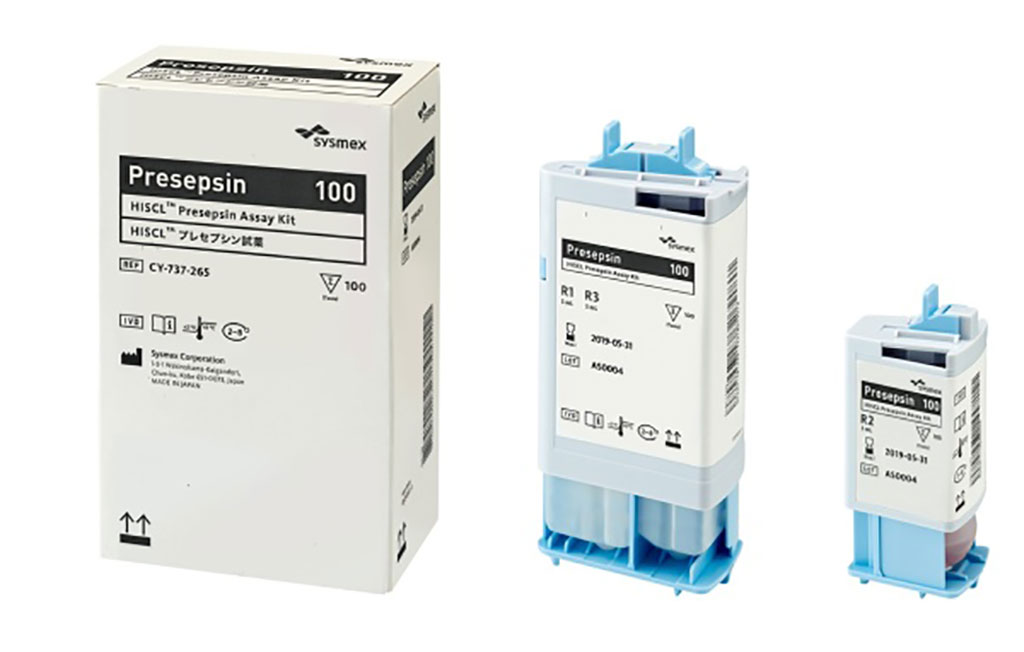Novel Presepsin Assay Evaluated Using Automated Immunoanalyzer
Posted on 27 Jul 2022
Biomarkers that reflect systemic responses during sepsis have been studied continuously, and there are various surrogate markers for the diagnosis of sepsis. Procalcitonin (PCT), C-reactive protein (CRP), cytokines, and chemokines have been studied extensively under the previous and revised sepsis definitions.
A soluble CD14 molecule (presepsin) has been developed and applied toward the diagnosis and prognosis of sepsis. Presepsin is a soluble CD14 molecule that is cleaved and released into the general circulation after activation by a monocyte or macrophage. Pathogen-associated molecular species such as lipopolysaccharide (LPS) from gram-negative bacteria can bind to serum lipoprotein-binding protein, both of which bind to CD14.

Biomedical Scientists at the Seoul St. Mary's Hospital, College of Medicine (Seoul, South Korea) collected samples from sepsis patients visiting the emergency department were collected before a treatment. Sepsis was diagnosed using a SOFA score with suspected bacterial infection. Reference intervals were analyzed and 124 subjects without underlying disease or prescribed medication from electronic medical records were selected.
For method comparison, 87 samples from suspected sepsis patients were collected within 24 hours from blood drawn and refrigerated at −80 °C for method comparison in duplicate. A total of 84 plasma from EDTA samples was analyzed with the chemiluminescence enzyme immunoassay by both Sysmex HISCL-5000 (Sysmex Corporation, Kobe, Japan) and PATHFAST (LSI Medience Corporation, Tokyo, Japan). For Sysmex HISCL-5000, the measurement range was from 0 to 30,000 pg/mL and for PATHFAST, the measurement range was from 0 to 20,000 pg/mL. Precision, linearity, limit of blank/limit of detection, method comparisons, and reference intervals were evaluated.
The investigators reported that precision using a 20×2×2 protocol for low (306 pg/mL) and high (1,031 pg/mL) levels resulted in within-laboratory standard deviation (95% confidence interval [CI]) and coefficient of variation (CV) %, which were as follows: 15.3 (13.1–18.7), 5.5% and 47.7, (40.5–58.1), 6.4%, respectively. Linearity using patient samples and calibrators were measured from 201 to 16,177 and 188 to 30,000 pg/mL, respectively. The correlation coefficient (95% CI) was 0.869 (0.772–0.927) with statistical significance. Reference intervals from 120 normal healthy subjects showed that 300 pg/mL was the cut off. Presepsin tended to show a higher value at higher ages and in males. A method comparison between Sysmex HISCL-5000 and PATHFAST was performed and the correlation coefficient was 0.979, which showed a high correlation coefficient.
The authors concluded that presepsin analyzed by HISCL-5000 showed reliable analytical performance that could be used in clinical settings. A wide range of analytical measurements ranging from 200 to 30,000 pg/mL was verified. As presepsin showed positive and negative correlations with hematocrit and renal function, careful interpretation is required for patients with underlying diseases involving red blood cells or kidneys. The study was published on July 23 2022 in the Journal of Clinical Laboratory Analysis.
Related Links:
Seoul St. Mary's Hospital, College of Medicine
Sysmex Corporation
LSI Medience Corporation









 Analyzer.jpg)




